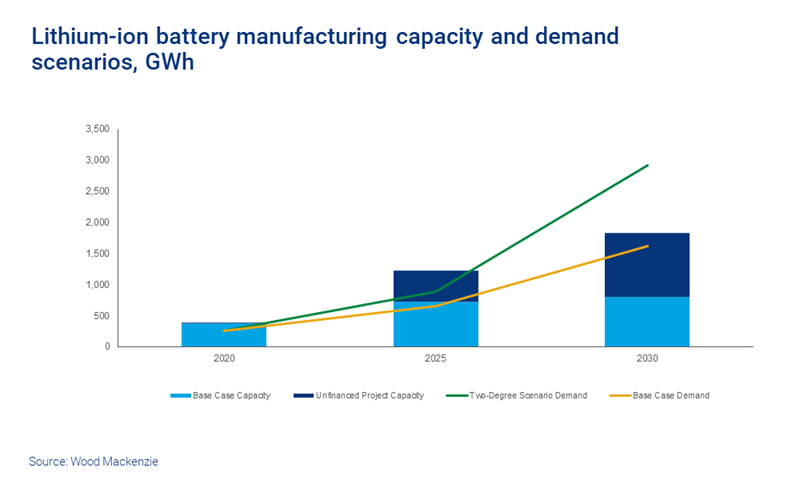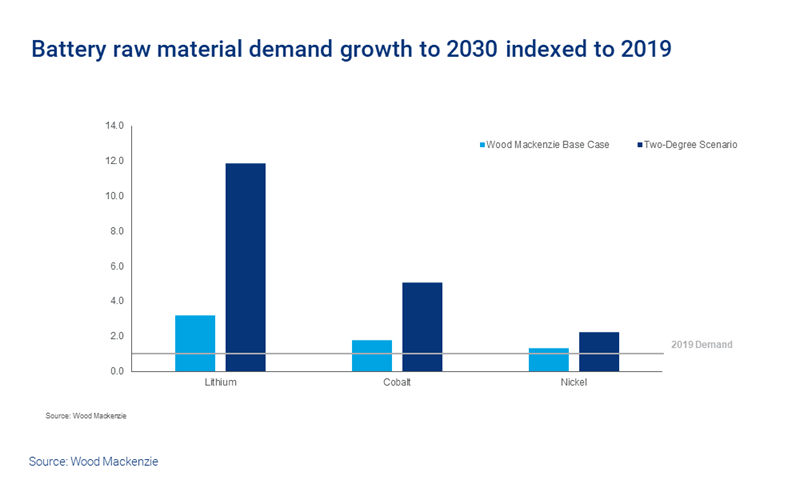Batteries: powering the fight against climate change
Why investment in battery manufacturing and storage technologies is critical to limiting global warming to 2°C
1 minute read
James Whiteside
Head of Corporate, Metals & Mining

James Whiteside
Head of Corporate, Metals & Mining
With 15 years of experience in the metals and mining industry, James leads our corperate coverage.
Latest articles by James
-
Opinion
The end of capital discipline in mining?
-
The Edge
Big Mining pivots to copper for growth
-
Featured
Metals & mining 2025 outlook
-
Opinion
Battery power play: countercyclical opportunities in raw materials
-
Opinion
Copper rush: A strategic analysis
-
Opinion
PPAs: transforming miners’ decarbonisation strategies
It’s been four years since the Paris Agreement was negotiated, yet global emissions have continued to rise each year. To achieve the agreed 2°C goal, global emissions need to peak as soon as possible and trend towards net-zero by 2070.
Major cities around the world have seen significant falls in greenhouse gasses in recent weeks as the coronavirus affects work, travel and industrial activity. As a consequence, many countries will unintentionally experience lower emissions this year.
After the global financial crisis in 2009, emissions rapidly rebounded with stimulus spending that boosted fossil fuel use. So how governments stimulate their economies once this pandemic eases will significantly impact future emissions. Sustained investment in renewable technologies is required now to reduce emissions over the longer term.
Roughly a third of today's greenhouse gas emissions come from the burning of fuel for road, air, rail and marine transport. This is the largest sector for emissions, more than even power, but battery technology has made both these sectors' emissions easier to abate. In contrast to industrial sectors like steel and cement, cost-competitive low-carbon technologies already exist for transport and power, and both rely upon batteries.
Is the battery value chain ready to support the decarbonisation of the power and transport sectors?
Under the Wood Mackenzie 2°C pathway, emissions from the transport sector must halve before 2040. To maintain the same level of transport connectivity, 900 million vehicles with a plug would need to be on the road by then, making up over half of the global fleet. But in 2019, just 10 million vehicles – 2% of the fleet – were electric. At its peak the EV industry would need to manufacture 70 million a year to replace internal combustion engine counterparts.
Likewise, wind and solar must generate the majority of electricity output by 2040. But generation at this level will only be enabled by having batteries in place to store the power for when it is required.
To provide these industries with the batteries required, manufacturing capacity needs to grow 10-fold, to just under 3,000 GWh in 2030. If all the currently planned manufacturing plants are constructed on schedule – a big if – the industry will still only grow to around 1,800 GWh by 2030. But right now, less than half this capacity has been financed. And that’s where some fundamental issues emerge.
Take the raw materials required for battery production. The nickel industry would need to double, cobalt supply would need to grow five times its current size while lithium would need to nearly 12 times to meet the requisite demand. The lithium industry must add capacity equivalent to the size of the entire industry in 2019 every year for the next decade. Meanwhile, the nickel industry alone would require over US$100 billion investment to build new capacity.
But it's not just the scale of investment required, it's the timing. Nickel is tricky – from discovery to production, it has among the longest development timeline of any mineral. On average, it takes almost a decade for an asset to go through all the study stages, construction and ramp-up to reach full production. Very few new lithium brine projects have been brought into production in recent years, and those that were, experienced comparably long lead times.
The current rate of development of the battery sector and raw materials is not enough to support emissions reductions in line with the 2°C target. Indeed, based on today's investment and technologies, Wood Mackenzie's outlook for energy markets forecasts emissions leading to 3°C warming by the end of this century.
To limit warming to 2°C, faster growth of battery manufacturing is the primary requirement, but the scarcity of raw materials drives the need for diversification of storage technologies as well. This includes more fuel cells to complement now-dominant lithium-ion batteries. Within lithium-ion itself, nickel-intensive chemistries must be supplemented by lower energy density cathode types like Tesla has picked for one of its Chinese models.
In short, sufficient decarbonisation of the transport and power sectors needs long-sighted investors to support the accelerated development of new capacity – and emerging technologies – across the battery value chain.
Learn more about supply-side challenges in an electrified world
Fill in the form on this page to receive a copy of the report by Gavin Montgomery, "Supply-side challenges in an electrified world". It includes:
- Our long-term demand forecasts for electric vehicles and battery raw materials, lithium, nickel and cobalt
- An overview of supply-side challenges for metals originating in Chile, Argentina, Bolivia, the DRC, Indonesia and more
- A discussion of who controls the supply chain and what that could mean for future supply








